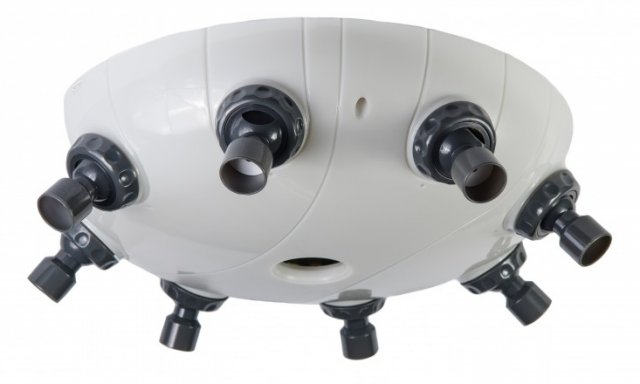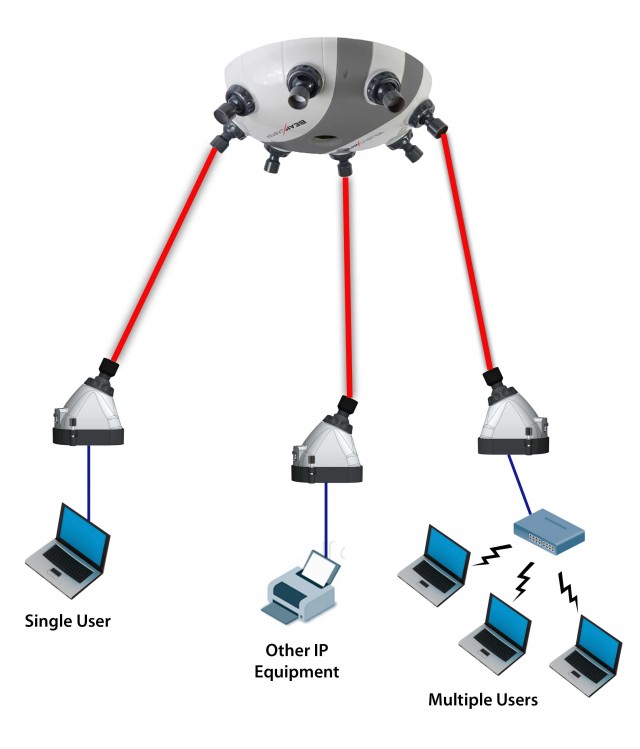
Beamcaster optical distribution unit sends out invisible beams of light to create wireless networks.
A new product called Beamcaster distributes beams of light to create wireless networks, providing an alternative or supplement to Wi-Fi and eliminating much of the cabling used to connect office workers to the Internet and corporate networks.
RiT Wireless, the makers of Beamcaster, demonstrated the technology this week at the Interop networking conference in Las Vegas. A Beamcaster "optical distribution unit" is mounted on a ceiling, distributing invisible beams of light to eight "smart outlets." (You might call them "frickin' laser beams.") In a typical setup, the smart outlets could be placed on top of a cubicle wall and hook up to PCs via Ethernet, giving workers access to the Internet and corporate networks. Connecting those smart outlets to standard switches would increase the number of PCs each smart outlet could connect to.
This setup reveals an obvious limitation—Smartphones and tablets typically don't have Ethernet ports. However, a Beamcaster smart outlet can connect to a WI-Fi router, distributing the signal to WI-Fi-capable devices. Future versions of the smart outlet will have 802.11ac Wi-Fi built in, RiT Wireless CTO Erez Ben Eshay told me at the Beamcaster booth yesterday.

Beamcaster topology.

Beamcaster's smart outlets receive signals from the optical distribution unit.
Beamcaster will be available in a few months, starting at $7,000 for the optical distribution unit and eight smart outlets. Ben Eshay acknowledges that it costs more than Wi-Fi access points, but he says it's cheaper than buying a switch and cabling infrastructure. The $7,000 unit provides 1Gbps of bandwidth, Ben Eshay said, but he prefers to think of it as 2Gbps because "it's a true bidirectional link at the same time." A unit costing $8,000 will provide a 10Gbps network (presumably 5Gbps each way).
Beamcaster is being sold through channel partners, and orders are expected to ship in July. Ben Eshay said a 100Gbps version will come later for about $12,000, but he didn't say when. He was quick to say that the network is limited only by the speed of light.
Who will buy it? RiT says Beamcaster will be useful "wherever high connectivity and easy installation are required, from offices to trade show booths, educational, and medical facilities." On a trade show floor, certainly, there would be advantages to setting up your own optical network instead of sharing the conference's Wi-Fi with other users. Whether it's worth the expense is another matter. In an office building where the network is devoted to just one set of users, Wi-Fi is often perfectly fine.
Ben Eshay claimed the optical wireless network is more robust than Wi-Fi because it has fewer problems related to users and devices sharing bandwidth. Still, he acknowledged that the 2Gbps or 10Gbps throughput amounts are hard limits, shared among devices connected to a Beamcaster network. A browser-based management tool will let administrators control how much bandwidth is allocated to each smart outlet.
RiT Wireless does engage in some scaremongering in a white paper on its website, claiming businesses should be worried about "the potential risk of radiation" from Wi-Fi. Beamcaster also claims that it has better security than we-Fi, going so far as to say that it is "100% unhackable."
While Beamcaster could well avoid some of the hacks that plague WI-Fi networks, any "unhackable" claim is hard to believe. As a PayPal's top security official, Michael Barrett, said today, "There is no such thing as a fully secure system." Each system has different degrees of risk, but there is risk in every system nonetheless, he said. (Barrett was discussing a new authentication system; he wasn't talking about Beamcaster specifically.)
In any case, Beamcaster says it uses "hack-proof optical links" and that "Every device (mobile or other) connected to the network has to be authorized, so [it] cannot authorize another ‘outlet’, reinforcing security." Tampering with the beams causes them to immediately shut down, Ben Eshay said.
While RiT Wireless believes Wi-Fi isn't as good as its beams of light, Wi-Fi is well accepted in the business world and is evolving to provide the kind of bandwidth Beamcaster promises. The new 802.11ad standard can provide up to 7Gbps of throughput on the 60Ghz band, with the same kinds of high-bandwidth, short-range communications as Beamcaster.
Connecting to the network
Beamcaster's optical distribution unit itself connects to a company's backend network via fiber. This setup requires a lot less cabling than traditional wired networks, RiT argues. "Upgrading of network infrastructure involves high costs and much downtime in order to install the new cabling and infrastructure," the company writes. "Upgrading... from 100Mps to GE [Gigabit Ethernet] entails more than just replacing ports and switches in the wiring closet. It involves much time and expense to deploy the cables and requires extensive management once installed."
Extending an organization's bandwidth long distances is also easier with Beamcaster, Ben Eshay said. "A copper cable can run 330 feet before it needs to see a switch. This unit can run 40 miles," he said, referring to the fiber connection from the data center to the office.
Once the signal is distributed via those light beams, it requires line-of-sight connections. This will be OK for workers in cubicles but not for their bosses in offices with actual doors.
More distribution units and smart outlets would be needed in those offices to get them connected through an optical link, although they could connect via Wi-Fi.
The beams are designed to travel up to 18 feet to a smart outlet, resulting in coverage of a 1,400-square-foot area. Distances could be increased if Beamcaster raised the power levels of its signal, but the levels were deliberately kept low for safety reasons. "The Beamcaster operates outside of the visible spectrum using very low power and is fully certified as a Class 1 laser product, safe under all conditions of normal use," the product website states. The beams are 2 millimeters wide and use about 20 microwatts of power, Ben Eshay said.
During setup, visible red beams are used to help humans create the point-to-point connections between the Beamcaster optical distribution unit and the smart outlets. Then it switches to the low power, invisible beams to distribute the actual network signals.
The receivers are designed to be extremely sensitive in order to pick up the low power signals. RiT has a patent pending on its technology.
If you're hungry for a little more, here's a marketing video the company made:
Beamcaster.
This comment has been removed by the author.
ReplyDeleteFiber Distribution Unit for servers is very sensitive but has its importance
ReplyDeletei know!! thanks for committing
Delete